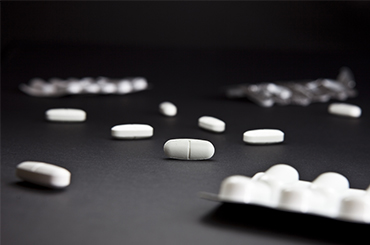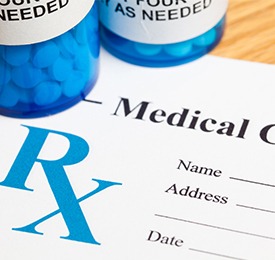- The Two Most Common Paths
- A Gray Zone of Prescription Drug Use
- The Challenges of Chemical Dependency
- Signs of Addiction
- Avoiding Addiction to Prescription Drugs
- Sources
According to the Partnership for a Drug-Free World, 15 million people become addicted to prescription drugs each year, and 52 million people have abused prescription drugs at some point—6.5 million in the last month, according to the National Institute on Drug Abuse.Prescription Drug Abuse Statistics
Prescription drugs are the leading source of drug addiction in the United States, with the CDC saying that prescription drug abuse has risen to epidemic levels.

This problem is a uniquely American one.
- The United States represents just 5% of the world's population but consumes 75% of its prescription drugs.
- A range of factors play a role in this: incredible affluence relative to other nations, a high rate of mental illness, and extremely stressful lifestyles.
However, it is hard to underestimate the role of over-reliance on prescription drugs within the medical industry.
The Two Most Common Paths
Believe it or not, prescription drug abuse can happen accidentally. This occurs when a doctor prescribes a potentially addictive drug and the patient grows dependent upon it.
- In some cases, patients find that the original dosage simply no longer works, and steadily up their dose, creating tolerance that ultimately leads to dependency.
- In other cases, a patient finds that when she no longer needs the drug, she experiences such intense withdrawal symptoms that she continues taking it.
- The CDC highlights the prominent role this plays in addiction, calling for increased physician attention to patient symptoms and to prescription-writing practices.
Of course, not all people who abuse prescription drugs have a valid medical prescription.
- Because these drugs are highly accessible, the contents of a parent's medicine cabinet can serve as a gateway drug for teenagers.
- People looking for an easy high, rapid relief from psychological pain, or a good night's sleep may self-medicate by borrowing or stealing a loved one's prescription.
- It's possible to become addicted even under the watchful supervision of a caring physician, but people who use prescription drugs non-medically are more likely to become addicted than those with valid prescriptions, according to the National Institute on Drug Abuse.
A Gray Zone of Prescription Drug Use

It's possible to have a valid medical prescription, follow your doctor's advice, and still be a prescription drug abuser.
- Some addicts occupy a gray zone of prescription drug abuse, and the reason for this is pretty simple: not all medical conditions manifest in a blood test or x-ray.
- Therefore, it is fairly easy to present “symptoms” or complaints to one’s doctor.
Mental health conditions such as anxiety and insomnia, some chronic pain conditions, and a handful of other ailments are diagnosed based on symptoms. Some people lie about their symptoms to gain access to prescription drugs.
Others self-diagnose to get drugs.
- For instance, a man who wants to stay up all night studying might tell his doctor he has symptoms of ADHD to get Ritalin.
- Alternatively, a woman who struggles with the normal concentration challenges we all periodically face might misdiagnose herself with ADHD.
- If her doctor does not carefully screen her for symptoms, she might end up with a potentially addictive prescription drug that she does not actually need.
- Her history of taking ADHD medications will then serve as evidence to future doctors that she needs these drugs!
The CDC points to the power of brief counseling sessions, open communication, and an emphasis on controlling symptoms with the lowest dose possible to combat the epidemic.
The Challenges of Chemical Dependency
No matter how you come to abuse prescription drugs, the ultimate outcome is the same: chemical dependency. Chemical dependency occurs when your body thinks it “needs” drugs to function.
If you suddenly stop using, your body reacts with powerful withdrawal symptoms that can send you back to abusing prescription drugs. Some of the most common symptoms of withdrawal include:
- Feeling jittery, depressed, anxious, or angry.
- Vomiting and diarrhea.
- Sleep disturbances.
- Headaches.
- Muscle aches and pains.
- Sweating, shaking, or unexplained coldness.
![]()
Signs of Addiction
Worried you might be addicted to prescription drugs? Here are some telltale symptoms:
- Using prescription drugs without a doctor's prescription, or at higher doses than recommended by your doctor.
- Lying to your doctor about your symptoms, or “doctor-shopping” to get multiple prescriptions.
- Experiencing difficult withdrawal symptoms when you attempt to quit using.
- Spending a significant portion of each day high on prescription drugs.
- Mixing multiple drugs to get a stronger effect.
Avoiding Addiction to Prescription Drugs
Sources
AMA calls for ban on direct to consumer advertising of prescription drugs and medical devices. (n.d.). Retrieved from http://www.ama-assn.org/ama/pub/news/2015/2015-11-17-ban-consumer-prescription-drug-advertising.page
Popping pills: Prescription drug abuse in America. (2014, January 02). Retrieved from http://www.drugabuse.gov/related-topics/trends-statistics/infographics/popping-pills-prescription-drug-abuse-in-america
Prescription and over-the-counter medications. (n.d.). Retrieved from http://www.drugabuse.gov/publications/drugfacts/prescription-over-counter-medications
Prescription drug abuse statistics. (n.d.). Retrieved from http://www.drugfreeworld.org/drugfacts/prescription/abuse-international-statistics.html
Prescription drug overdose data. (2015, October 16). Retrieved from http://www.cdc.gov/drugoverdose/data/overdose.html
Understanding the epidemic. (2015, October 28). Retrieved from http://www.cdc.gov/drugoverdose/epidemic/